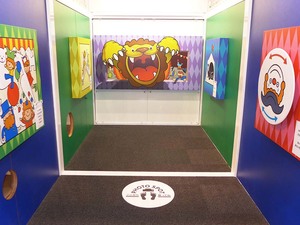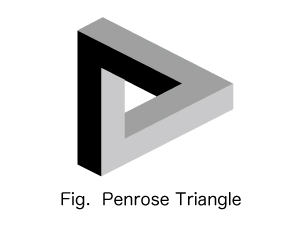Nagoya City Science Museum
TOP > Exhibition Guide > Keyword Search > Starting with "P" > perceptual_illusion > Trompe l'oeil
Trompe l'oeil



Purpose of Exhibition
You can enjoy “trompe l’oeil” (tricks of the eye), an art technique that uses realistic imagery to create optical illusions of depth: for example, an optical illusion of two images embedded in the same picture, and three-dimensional images that do not exist in the real world.
Additional Knowledge
[Clown or Old Man?]
Rotate the disk, and you will see either a clown or an old man. By turning the picture upside down, a new image emerges. This type of visual illusion, called an “upside-down picture,” has been so popular since long ago that many different works have been created so far. There might be a few works you are familiar with.
Turn the face photo upside down, and the image will look very different such that the upside-down image and upright image are hard to recognize as being the same face, a phenomenon called the “face-inversion effect.” Upside-down pictures make optimal use of the face-inversion effect.
There is one very intriguing optical illusion based on the face-inversion effect called the “Thatcher illusion.” When the photo of an inverted face is presented, you may not feel it weird, but when the upside-down face is rotated to show the upright face, you will be surprised to see how strange the upright version looks.
[Whale or Elephant?]
What kind of animal is under the circus tent? Some see a whale there, while others see an elephant. One image can be interpreted in two different ways, which is called an “ambiguous figure.” A classic example is an ambiguous duck/rabbit figure. Another is an image that presents viewers with a mental choice of two interpretations: one of a young woman looking back over her shoulder, the other an elderly woman in profile looking down. Rubin’s Vase is another type of ambiguous image that can be interpreted in two different ways. The image depicts a white vase in the center with a black background, allowing viewers to interpret it as either “a vase” or “the silhouettes of two faces in profile looking at each other.” However, Rubin’s Vase – in which these reversible interpretations are possible by alternatively interpreting the black areas as figure or ground – is a different type than the pictures displayed here.
[Five Animals Escaping from the Circus]
In the picture of a circus team, five animals are in hiding. Can you see the image of animals depicted using the contours of people and balloons? This version is relatively easy to find the animals. Some images of this type, which are often painted by artists, are more difficult. If you encounter such a challenging image, try it and have fun.
[Lion and Tiger Climbing Stairs]
A lion and a tiger are climbing up different sets of stairs connecting two floors. Which floor do you think is higher, and which is lower? When you look at the lion, the floor on the left seems to be higher. When you look at the tiger, however, the floor on the right side looks to be the upper level. The more you look, the more difficult it is to tell which is higher or lower.
This type of image is called an “impossible figure” or “impossible object.” What is impossible is that such an image, which consists of a two-dimensional figure, cannot be turned into a three-dimensional object. A wide variety of impossible figures like this exist that are pleasing to the eye. One famous impossible figure is the Penrose Triangle, first created by Swedish artist Oscar Reutersvärd in 1934.
The image of stairs on display is called an “infinite staircase.” A representative example is “Ascending and descending” by Dutch artist M.C. Escher. Akiyoshi Kitaoka, Professor at Ritsumeikan University, has presented a “really minimum infinite staircase” consisting of three stair steps.
The Penrose Triangle is an impossible figure that does not exist in the real world. This object is visible only when viewed from a certain direction.
[Nearly Eaten by a Lion!]
Place your head in front of the mouth of the lion, and take your photo. It looks as if the lion is nearly eating you. This is called “trick art,” which is so popular that you might encounter it at various places. A tip for taking interesting photos is to create various facial expressions and hold various poses.
Article by Yoshitaka Yamada, curator
